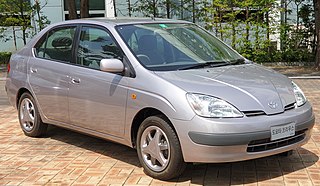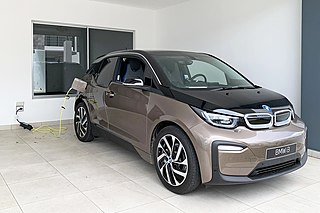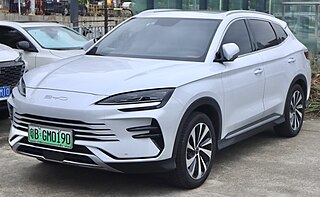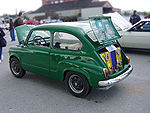
A hybrid vehicle is one that uses two or more distinct types of power, such as submarines that use diesel when surfaced and batteries when submerged. Other means to store energy include pressurized fluid in hydraulic hybrids.

An electric vehicle (EV) is a vehicle that uses one or more electric motors for propulsion. The vehicle can be powered by a collector system, with electricity from extravehicular sources, or can be powered autonomously by a battery or by converting fuel to electricity using a generator or fuel cells. EVs include road and rail vehicles, electric boats and underwater vessels, electric aircraft and electric spacecraft.

The Toyota RAV4 EV is an all-electric version of the popular RAV4 SUV produced by Toyota until 2014. Two generations of the EV model were sold in California, and to fleets elsewhere in the US, with a gap of almost ten years between them.

A plug-in hybrid electric vehicle (PHEV) or simply plug-in hybrid is a type of hybrid electric vehicle equipped with a rechargeable battery pack that can be directly replenished via a charging cable plugged into an external electric power source, in addition to charging internally by its on-board internal combustion engine-powered generator. While PHEVs are predominantly passenger cars, there are also plug-in hybrid variants of sports cars, commercial vehicles, vans, utility trucks, buses, trains, motorcycles, mopeds, military vehicles and boats.

An electric truck is a battery electric vehicle (BEV) designed to transport cargo, carry specialized payloads, or perform other utilitarian work.

An electric bicycle, e-bike, electrically assisted pedal cycles, or electrically power assisted cycles is a motorized bicycle with an integrated electric motor used to assist propulsion. Many kinds of e-bikes are available worldwide, but they generally fall into two broad categories: bikes that assist the rider's pedal-power and bikes that add a throttle, integrating moped-style functionality. Both retain the ability to be pedaled by the rider and are therefore not electric motorcycles. E-bikes use rechargeable batteries and typically are motor-powered up to 25 to 32 km/h. High-powered varieties can often travel more than 45 km/h (28 mph).
Hybrid vehicle drivetrains transmit power to the driving wheels for hybrid vehicles. A hybrid vehicle has multiple forms of motive power.

Electric motorcycles and scooters are plug-in electric vehicles with two or three wheels. Power is supplied by a rechargeable battery that drives one or more electric motors. Electric scooters are distinguished from motorcycles by having a step-through frame, instead of being straddled. Electric bicycles are similar vehicles, distinguished by retaining the ability to be propelled by the rider pedaling in addition to battery propulsion.

A charging station, also known as a charge point, chargepoint, or electric vehicle supply equipment (EVSE), is a power supply device that supplies electrical power for recharging plug-in electric vehicles.

A solar car is a solar vehicle for use on public roads or race tracks. Solar vehicles are electric vehicles that use self-contained solar cells to provide full or partial power to the vehicle via sunlight. Solar vehicles typically contain a rechargeable battery to help regulate and store the energy from the solar cells and from regenerative braking. Some solar cars can be plugged into external power sources to supplement the power of sunlight used to charge their battery.

An electric vehicle battery is a rechargeable battery used to power the electric motors of a battery electric vehicle (BEV) or hybrid electric vehicle (HEV).

An electric car or electric vehicle (EV) is a passenger automobile that is propelled by an electric traction motor, using electrical energy as the primary source of propulsion. The term normally refers to a plug-in electric vehicle, typically a battery electric vehicle (BEV), which only uses energy stored in on-board battery packs, but broadly may also include plug-in hybrid electric vehicle (PHEV), range-extended electric vehicle (REEV) and fuel cell electric vehicle (FCEV), which can convert electric power from other fuels via a generator or a fuel cell.

A battery electric vehicle (BEV), pure electric vehicle, only-electric vehicle, fully electric vehicle or all-electric vehicle is a type of electric vehicle (EV) that exclusively uses chemical energy stored in rechargeable battery packs, with no secondary source of propulsion. BEVs use electric motors and motor controllers instead of internal combustion engines (ICEs) for propulsion. They derive all power from battery packs and thus have no internal combustion engine, fuel cell, or fuel tank. BEVs include – but are not limited to – motorcycles, bicycles, scooters, skateboards, railcars, watercraft, forklifts, buses, trucks, and cars.

Enova Systems was a United States corporation which designed and supplied battery electric vehicle powertrains and components. The company was founded initially as Clover Solar Corporation on July 30, 1976, in Santa Rosa, California, and changed its name to Solar Electric Engineering in June 1979.
Pakistan has a significant market for hybrid vehicles such as Honda's Vezel, Toyota's Prius, and Aqua. The Automotive Development Policy (2016–2021) and the launch of the China-Pakistan Economic Corridor (CPEC) encourage foreign investments for new automobile brands to enter the Pakistani market.
There are numerous versions of vehicle propulsion systems. Many of those came into fruition due to need for cleaner vehicles. Each of them might have many abbreviations and some might be misleading. This article explains shortly what defines them.
Gridserve Sustainable Energy Limited, stylised as GRIDSERVE, is a British company founded in 2017 to develop, own and operate critical infrastructure for sustainable energy production. Gridserve opened the UK's first all-electric car charging forecourt in 2020, with the second opening in April 2022 and plans to introduce several more in the coming years to charge electric vehicles with 100% renewable energy, supporting the UK's transition to carbon neutrality. The company capitalises its name.

IrishEVs is a consumer advice website focusing on electric vehicles, renewable energy and the climate crisis in Ireland. The site was founded by journalist Tom Spencer, who previously wrote for Fully Charged, and has covered a wide range of topics around the role of cars and transport in the context of climate change – with the transport sector accounting for 20% of Ireland's total greenhouse gas emissions.
An electromod is a vehicle that has been restored and modified by converting its drivetrain to operate as an electric vehicle (EV). The term is a portmanteau of electrification and restomod, itself a portmanteau of restoration and modification, a process which traditionally has been associated with classic cars. Most electromods are one-off custom vehicles performed by specialty repair shops and hobbyists, but starting in the late 2010s, automobile manufacturers have been building their own electromods, sometimes with the assistance of specialty shops, to publicize their shift to battery electric powertrains and to build interest in crate engine EV drivetrain products.




















